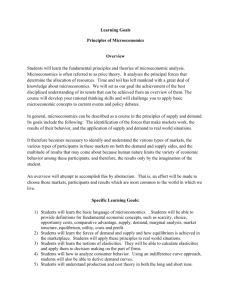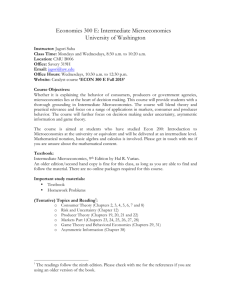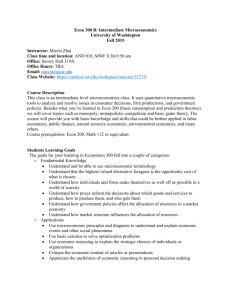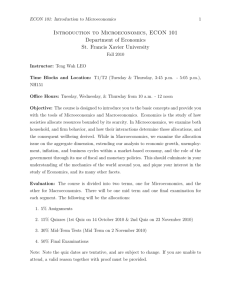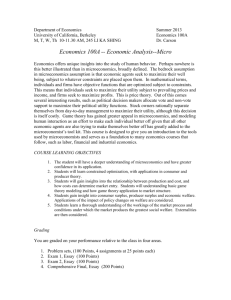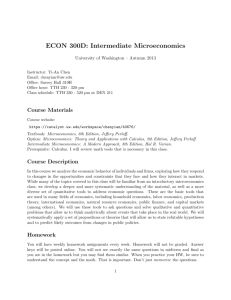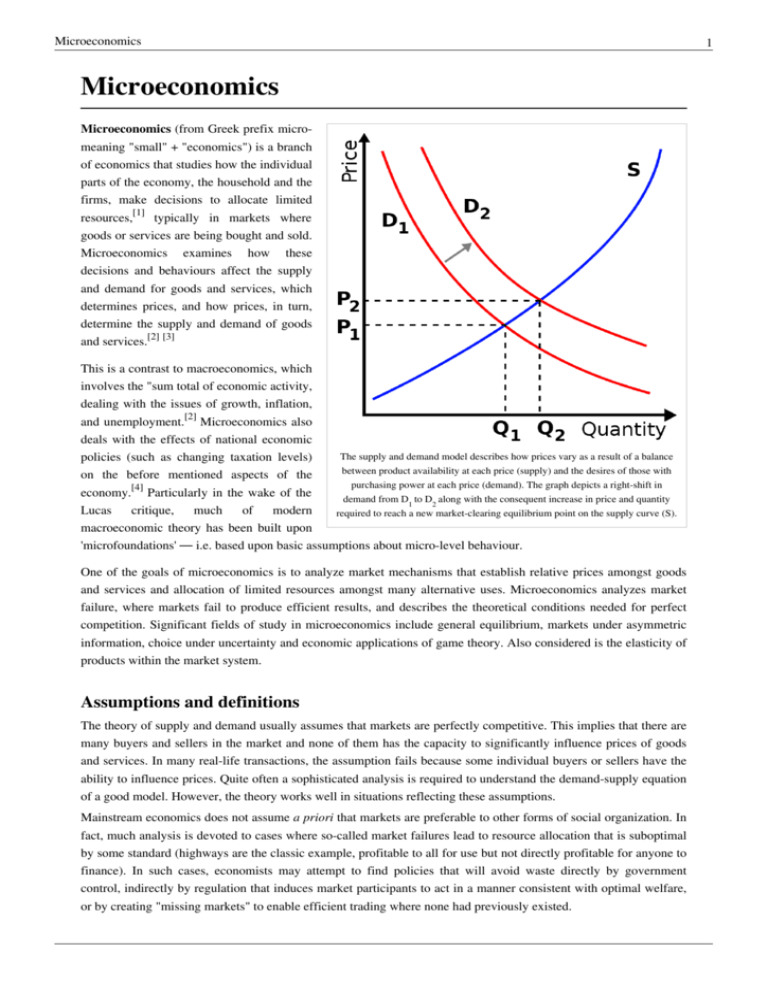
Microeconomics
Microeconomics
Microeconomics (from Greek prefix micromeaning "small" + "economics") is a branch
of economics that studies how the individual
parts of the economy, the household and the
firms, make decisions to allocate limited
resources,[1] typically in markets where
goods or services are being bought and sold.
Microeconomics examines how these
decisions and behaviours affect the supply
and demand for goods and services, which
determines prices, and how prices, in turn,
determine the supply and demand of goods
and services.[2] [3]
This is a contrast to macroeconomics, which
involves the "sum total of economic activity,
dealing with the issues of growth, inflation,
and unemployment.[2] Microeconomics also
deals with the effects of national economic
The supply and demand model describes how prices vary as a result of a balance
policies (such as changing taxation levels)
between product availability at each price (supply) and the desires of those with
on the before mentioned aspects of the
purchasing power at each price (demand). The graph depicts a right-shift in
[4]
economy. Particularly in the wake of the
demand from D1 to D2 along with the consequent increase in price and quantity
Lucas
critique,
much
of
modern
required to reach a new market-clearing equilibrium point on the supply curve (S).
macroeconomic theory has been built upon
'microfoundations' — i.e. based upon basic assumptions about micro-level behaviour.
One of the goals of microeconomics is to analyze market mechanisms that establish relative prices amongst goods
and services and allocation of limited resources amongst many alternative uses. Microeconomics analyzes market
failure, where markets fail to produce efficient results, and describes the theoretical conditions needed for perfect
competition. Significant fields of study in microeconomics include general equilibrium, markets under asymmetric
information, choice under uncertainty and economic applications of game theory. Also considered is the elasticity of
products within the market system.
Assumptions and definitions
The theory of supply and demand usually assumes that markets are perfectly competitive. This implies that there are
many buyers and sellers in the market and none of them has the capacity to significantly influence prices of goods
and services. In many real-life transactions, the assumption fails because some individual buyers or sellers have the
ability to influence prices. Quite often a sophisticated analysis is required to understand the demand-supply equation
of a good model. However, the theory works well in situations reflecting these assumptions.
Mainstream economics does not assume a priori that markets are preferable to other forms of social organization. In
fact, much analysis is devoted to cases where so-called market failures lead to resource allocation that is suboptimal
by some standard (highways are the classic example, profitable to all for use but not directly profitable for anyone to
finance). In such cases, economists may attempt to find policies that will avoid waste directly by government
control, indirectly by regulation that induces market participants to act in a manner consistent with optimal welfare,
or by creating "missing markets" to enable efficient trading where none had previously existed.
1
Microeconomics
This is studied in the field of collective action. It also must be noted that "optimal welfare" usually takes on a
Paretian norm, which in its mathematical application of Kaldor–Hicks method, does not stay consistent with the
Utilitarian norm within the normative side of economics which studies collective action, namely public choice.
Market failure in positive economics (microeconomics) is limited in implications without mixing the belief of the
economist and his or her theory.
The demand for various commodities by individuals is generally thought of as the outcome of a utility-maximizing
process. The interpretation of this relationship between price and quantity demanded of a given good is that, given
all the other goods and constraints, this set of choices is that one which makes the consumer happiest.
Modes of operation
It is assumed that all firms are following rational decision-making, and will produce at the profit-maximizing output.
Given this assumption, there are four categories in which a firm's profit may be considered.
• A firm is said to be making an economic profit when its average total cost is less than the price of each additional
product at the profit-maximizing output. The economic profit is equal to the quantity output multiplied by the
difference between the average total cost and the price.
• A firm is said to be making a normal profit when its economic profit equals zero. This occurs where average total
cost equals price at the profit-maximizing output.
• If the price is between average total cost and average variable cost at the profit-maximizing output, then the firm
is said to be in a loss-minimizing condition. The firm should still continue to produce, however, since its loss
would be larger if it were to stop producing. By continuing production, the firm can offset its variable cost and at
least part of its fixed cost, but by stopping completely it would lose the entirety of its fixed cost.
• If the price is below average variable cost at the profit-maximizing output, the firm should go into shutdown.
Losses are minimized by not producing at all, since any production would not generate returns significant enough
to offset any fixed cost and part of the variable cost. By not producing, the firm loses only its fixed cost. By losing
this fixed cost the company faces a challenge. It must either exit the market or remain in the market and risk a
complete loss.
Opportunity cost
Opportunity cost of an activity (or goods) is equal to the best next alternative foregone. Although opportunity cost
can be hard to quantify, the effect of opportunity cost is universal and very real on the individual level. In fact, this
principle applies to all decisions, not just economic ones. Since the work of the Austrian economist Friedrich von
Wieser, opportunity cost has been seen as the foundation of the marginal theory of value.
Opportunity cost is one way to measure the cost of something. Rather than merely identifying and adding the costs
of a project, one may also identify the next best alternative way to spend the same amount of money. The forgone
profit of this next best alternative is the opportunity cost of the original choice. A common example is a farmer that
chooses to farm her or his land rather than rent it to neighbors, wherein the opportunity cost is the forgone profit
from renting. In this case, the farmer may expect to generate more profit alone. Similarly, the opportunity cost of
attending university is the lost wages a student could have earned in the workforce, rather than the cost of tuition,
books, and other requisite items (whose sum makes up the total cost of attendance). The opportunity cost of a
vacation in the Bahamas might be the down payment for a house.
Note that opportunity cost is not the sum of the available alternatives, but rather the benefit of the single, best
alternative. Possible opportunity costs of a city's decision to build a hospital on its vacant land are the loss of the land
for a sporting center, or the inability to use the land for a parking lot, or the money that could have been made from
selling the land, or the loss of any of the various other possible uses — but not all of these in aggregate. The true
opportunity cost would be the forgone profit of the most lucrative of those listed.
2
Microeconomics
One question that arises here is how to determine a money value for each alternative to facilitate comparison and
assess opportunity cost, which may be more or less difficult depending on the things we are trying to compare. For
example, many decisions involve environmental impacts whose monetary value is difficult to assess because of
scientific uncertainty. Valuing a human life or the economic impact of an Arctic oil spill involves making subjective
choices with ethical implications.
It is imperative to understand that nothing is free. No matter what one chooses to do, he or she is always giving
something up in return. An example of opportunity cost is deciding between going to a concert and doing homework.
If one decides to go the concert, then he or she is giving up valuable time to study, but if he or she chooses to do
homework then the cost is giving up the concert. Opportunity cost is vital in understanding microeconomics and
decisions that are made.
Applied microeconomics
Applied microeconomics includes a range of specialized areas of study, many of which draw on methods from other
fields. Applied work often uses little more than the basics of price theory, supply and demand. Industrial
organization and regulation examines topics such as the entry and exit of firms, innovation, role of trademarks. Law
and economics applies microeconomic principles to the selection and enforcement of competing legal regimes and
their relative efficiencies. Labor economics examines wages, employment, and labor market dynamics. Public
finance (also called public economics) examines the design of government tax and expenditure policies and
economic effects of these policies (e.g., social insurance programs).
Political economy examines the role of political institutions in determining policy outcomes. Health economics
examines the organization of health care systems, including the role of the health care workforce and health
insurance programs. Urban economics, which examines the challenges faced by cities, such as sprawl, air and water
pollution, traffic congestion, and poverty, draws on the fields of urban geography and sociology.
The field of financial economics examines topics such as the structure of optimal portfolios, the rate of return to
capital, econometric analysis of security returns, and corporate financial behavior. The field of economic history
examines the evolution of the economy and economic institutions, using methods and techniques from the fields of
economics, history, geography, sociology, psychology, and political science.
Further reading
• Bade, Robin; Michael Parkin (2001). Foundations of Microeconomics. Addison Wesley Paperback 1st Edition.
• Colander, David. Microeconomics. McGraw-Hill Paperback, 7th Edition: 2008.
• Dunne, Timothy, J. Bradford Jensen, and Mark J. Roberts (2009). Producer Dynamics: New Evidence from Micro
Data. University of Chicago Press. ISBN 9780226172569.
• Eaton, B. Curtis; Eaton, Diane F.; and Douglas W. Allen. Microeconomics. Prentice Hall, 5th Edition: 2002.
• Frank, Robert A.; Microeconomics and Behavior. McGraw-Hill/Irwin, 6th Edition: 2006.
• Friedman, Milton. Price Theory. Aldine Transaction: 1976
• Hagendorf, Klaus: Labour Values and the Theory of the Firm. Part I: The Competitive Firm. Paris: EURODOS;
2009. [5]
• Harberger, Arnold C., 2008. "Microeconomics," [6] The Concise Encyclopedia of Economics.
• Hicks, John R. Value and Capital. Clarendon Press. [1939] 1946, 2nd ed.
• Jehle, Geoffrey A.; and Philip J. Reny. Advanced Microeconomic Theory. Addison Wesley Paperback, 2nd
Edition: 2000.
• Katz, Michael L.; and Harvey S. Rosen. Microeconomics. McGraw-Hill/Irwin, 3rd Edition: 1997.
• Kreps, David M. A Course in Microeconomic Theory. Princeton University Press: 1990
• Landsburg, Steven. Price Theory and Applications. South-Western College Pub, 5th Edition: 2001.
• Mankiw , N. Gregory. Principles of Microeconomics. South-Western Pub, 2nd Edition: 2000.
3
Microeconomics
• Mas-Colell, Andreu; Whinston, Michael D.; and Jerry R. Green. Microeconomic Theory. Oxford University
Press, US: 1995.
• McGuigan, James R.; Moyer, R. Charles; and Frederick H. Harris. Managerial Economics: Applications, Strategy
and Tactics. South-Western Educational Publishing, 9th Edition: 2001.
• Nicholson, Walter. Microeconomic Theory: Basic Principles and Extensions. South-Western College Pub, 8th
Edition: 2001.
• Perloff, Jeffrey M. Microeconomics. Pearson - Addison Wesley, 4th Edition: 2007.
• Perloff, Jeffrey M. Microeconomics: Theory and Applications with Calculus. Pearson - Addison Wesley, 1st
Edition: 2007
• Pindyck, Robert S.; and Daniel L. Rubinfeld. Microeconomics. Prentice Hall, 7th Edition: 2008.
• Ruffin, Roy J.; and Paul R. Gregory. Principles of Microeconomics. Addison Wesley, 7th Edition: 2000.
• Varian, Hal R. (1987). "microeconomics," The New Palgrave: A Dictionary of Economics, v. 3, pp. 461-63.
• Varian, Hal R. Intermediate Microeconomics. W.W. Norton & Company, 7th Edition.
• Varian, Hal R. Microeconomic Analysis. W. W. Norton & Company, 3rd Edition.
External links
• Open Source Introduction to Microeconomics [7] (see wiki article) by R. Preston McAfee - California Institute of
Technology
• Amosweb.com homepage [8] - online economics dictionary
• X-Lab: A Collaborative Micro-Economics and Social Sciences Research Laboratory [9]
• Micro Economics [10] - the role of micro economics in supporting the social fabric of macro economies
• Simulations in Microeconomics [11]
References
[1] Marchant, Mary A.; Snell, William M.. "Macroeconomic and International Policy Terms" (http:/ / www. ca. uky. edu/ agc/ pubs/ aec/ aec75/
aec75. pdf). University of Kentucky. . Retrieved 2007-05-04.
[2] "Economics Glossary" (http:/ / www. mcwdn. org/ ECONOMICS/ EcoGlossary. html). Monroe County Women's Disability Network. .
Retrieved 2008-02-22.
[3] "Social Studies Standards Glossary" (http:/ / web. archive. org/ web/ 20070808200604/ http:/ / nmlites. org/ standards/ socialstudies/ glossary.
html). New Mexico Public Education Department. . Retrieved 2008-02-22.
[4] "Glossary" (http:/ / www. econ100. com/ eu5e/ open/ glossary. html). ECON100. . Retrieved 2008-02-22.
[5] http:/ / ssrn. com/ paper=1489383
[6] http:/ / www. econlib. org/ library/ Enc/ Microeconomics. html
[7] http:/ / www. introecon. com/
[8] http:/ / www. amosweb. com/ cgi-bin/ awb_nav. pl?s=gls
[9] http:/ / xlab. berkeley. edu
[10] http:/ / www. standardsoflife. com/ Micro+ Economics
[11] http:/ / www. economicsnetwork. ac. uk/ teaching/ simulations/ principlesofmicroeconomics. htm
4
Article Sources and Contributors
Article Sources and Contributors
Microeconomics Source: http://en.wikipedia.org/w/index.php?oldid=386494741 Contributors: 65.29.20.xxx, A Stop at Willoughby, APH, Aadieu, Abraham, Adashiel, Addihockey10,
AdidasGuy, Aesopos, Aetheling, Alasdair, Aleksd, AnakngAraw, Andgold, Andre Engels, Anne, Aristolaos, AscendedAnathema, Assyria 90, Avono, Baronnet, Betterusername, Bkwillwm,
Blahblah32blahblah, Blanchardb, Bluezy, Bmunden, Bomac, Bongwarrior, Borgx, Bryan Derksen, Burn, CONSERVATION MATTERS, CRGreathouse, Captain-tucker, Cessator,
Chrishomingtang, Church of emacs, Clarince63, Closedmouth, Conversion script, Cretog8, D6, DCDuring, DVD R W, Darkfight, DavidLevinson, Dbtfz, Dick Bos, Diego Moya, Dinkar jha,
Drsunil75, Dupz, EPO, Earth, Eastlaw, Economics1055, Edpedia, Edward, El C, Enchanter, Eug, EunuchOmerta, Eurodos, Fang Aili, Fconaway, FrankTobia, Fvw, Gary King, Gene Nygaard,
GeoMor, Ghazer, Gilliam, Gnangarra, Gnixon, Grampion76, Grcampbell, Grick, Grysbok, Harthacnut, Hectorthebat, Hefaistos, HelenWatt, Hike395, Hkswadhin, HoodedMan, Hotel Caliphate,
Humanman651, Hurmata, Ivan Bajlo, J.delanoy, JIP, JavOs, Jaxl, Jayden54, Jc215flip, Jdevine, Jgrischow1, John JD Doe, John Quiggin, Joseph Solis in Australia, Jrincayc, Julie966, K95,
Kajasudhakarababu, Karimarie, Kibtong, Killalotz, Kingpin13, Kmarinas86, Knownot, KrakatoaKatie, Kuru, Kyphe, L33th4x0rguy, Ladwiki, Lawrencekhoo, Levineps, Linderfiken, Little
Mountain 5, Longest Journey, Luckas Blade, MER-C, Maliseraph, Manop, Mark83, Mathninja, Maurreen, Melchoir, Michael Hardy, Michael Snow, Michele123, Midnight286, Mimihitam,
Miwanya, Morphh, Mrushbenton, Mydogategodshat, N2e, N8chz, Nakos2208, Nev1, Nikodemos, Nooj, Novacatz, Nuance13x, Omicronpersei8, Omnipaedista, OnBeyondZebrax, Oxymoron83,
Palica, Pamri, Patrick, Pcarbonn, Philip Trueman, Piotrus, Pnettleship, Pokrajac, Porqin, Pouchkidium, Psychobabble, Purgatory Fubar, Qst, Radeksz, Rama's Arrow, Rashack, Rdsmith4,
RedWordSmith, Remy B, Revan ltrl, Rhysn, Rich Farmbrough, Ricky81682, Rinconsoleao, Rjhansen, Rmwillemsen, Robertson-Glasgow, Rsnzaman, SMP, ST47, Salsa Shark, Scyth, Sean
Antrim, Seijihyouronka, Sharkface217, Sikandros, SilverStar, Socceroos91, Soliloquial, Son of fire, Spliffy, Standardsoflife, Stevencgold, Stuffisthings, Tangpa, Tarotcards, Taxman, Tdseay,
Techman224, Tender LC, The Land, The undertow, Theo10011, Thingg, ThomasStrohmann, Thomasmeeks, Tide rolls, Time4this, Tobacman, Togo, Trebor, Trombe29, UAAC, UBeR,
UbiquitousUK, Unforgettableid, VMS Mosaic, Wanders1, Wikiofrahul, Williamsrus, Winstud, WojPob, Woohookitty, Yerpo, Youssefsan, Zeerus, Zeneky, Zotzotmngt10, Александър, 348
anonymous edits
Image Sources, Licenses and Contributors
Image:Supply-demand-right-shift-demand.svg Source: http://en.wikipedia.org/w/index.php?title=File:Supply-demand-right-shift-demand.svg License: Creative Commons Attribution 2.5
Contributors: Original uploader was SilverStar at en.wikipedia
License
Creative Commons Attribution-Share Alike 3.0 Unported
http:/ / creativecommons. org/ licenses/ by-sa/ 3. 0/
5


